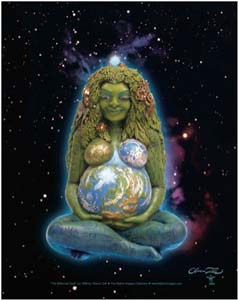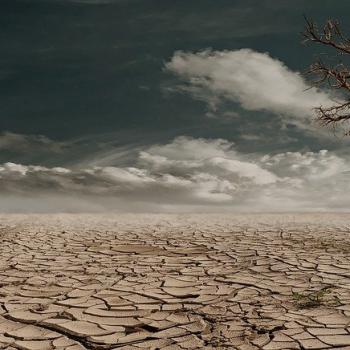By Oberon Zell
 The Millennial Gaia by Oberon Zell
The Millennial Gaia by Oberon Zell
The only myth that is going to be worth thinking about in the immediate future is one that is talking about the planet. . . and everybody on it. . . This might be the symbol, really, for the new mythology to come. ~ Joseph Campbell, The Power of Myth
The conception of the Earth as a living, self-organising system, known today as Gaia theory, is an ancient idea and yet one of the most radical and far-reaching scientific theories of the 20th century. ~ Fritjof Capra, The Tao of Physics
Few ideas since the Second World War have challenged prevailing orthodoxies as compelling as Jim Lovelock's Gaia hypothesis. ~ Jonathon Porrit, English environmentalist and writer
[The Gaia Thesis] may turn out to be one of the epochal insights of the 20th century. ~ CoEvolution Quarterly
Gaea, the Earth Mother in Human Cultures
Homer's Hymn to Gaea begins: "Of Earth I sing, eldest of all and Mother of the Gods. . ."
Homer's reference to Gaea, (Gaia) the name given by the ancient Greeks to the primordial planetary goddess worshipped by humanity since the dawn of human awareness, is still relevant today. An even more ancient form of this name, Ge, is the root of the names of the Earth sciences, Geology, Geography, and Geophysics.
Even small children intuitively recognize Mother Earth. She is the oldest and most universally worshipped archetype in all of human experience. Her images and figurines date back to the Cro-Magnon Aurignacian peoples of over 30,000 years ago, and are found across the Eurasian continent from Spain to Siberia, spanning a time period of over 20,000 years.
More recently, new and awesome images of the Earth Mother have come to us in stunning photos taken from space of our planet. Since the late 1960s these images of the Earth have awakened people to a vision of the World as a whole entity. Awareness of this planetary integrity has caused the name of Gaea (Gaia) to re-emerge in the form of "The Gaea Thesis," which states, in short, that our entire planet is a single vast living organism, composed of all the Earth's living organisms. Natural science has turned once again to contemplate Gaea as a whole, using the name the Ancient Greek philosophers gave to Mother Earth.
Spirituality and Science Reconciled
On September 6, 1970, I had a dramatic visionary and mystical experience that altered completely the course of my life and work:
While a few hours went by on the clock, I experienced through my own body, the entire history and consciousness of the living Earth. It was an experience of projecting myself back to the first cell that ever was and dividing and dividing until I felt my own presence, through the DNA molecule, in all life and an awareness of the presence of all life within me. An immense amount of information and the organic wisdom of Gaea flooded through me. I felt irrevocably bonded to the Earth and blessed by Her. Since then, Gaea's living presence has never left me. I have devoted myself to the people, places, and groups that, to me, best express Gaea's being and needs as I experience it; one biosphere, one organism, one Being.
This deeply spiritual experience had its basis in science. Since it is generally accepted by biologists, and demonstrable from comparative analyses of DNA, that all life on Earth has derived from a single original cell, it follows that the aggregate of Earth's life forms constitutes a single vast creature. This creature, this Being, may be precisely identified with the entity referred to since ancient times as "Mother Earth, Gaea."
My first paper detailing this thesis, titled "TheaGenesis: The Birth of the Goddess" was subsequently published in 1971 as a lead article in Green Egg, vanguard journal of the (then) newly-emerging Neo-Pagan religious movement. The introduction of "TheaGenesis" as a theological premise electrified the movement, generating volumes of correspondence, lecture tours, and further articles in various journals and books.
In 1972, James Lovelock, an atmospheric biochemist residing in England, published a Letter to the Editors titled "Gaia as Seen through the Atmosphere" in the journal Atmospheric Environment. This was Lovelock's first published reference to the notion, and the first use of the name "Gaia" as a scientific reference to Earth's planetary biosphere. In later writings, Lovelock came to refer to this concept as "The Gaia Hypothesis."




